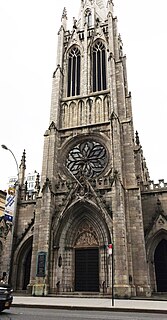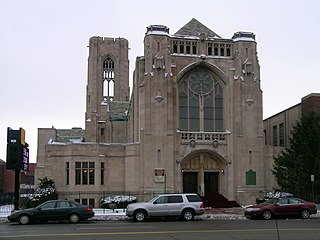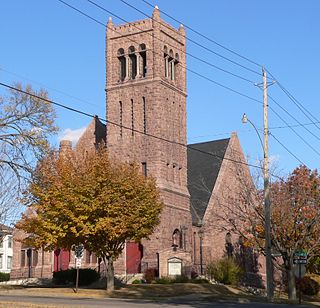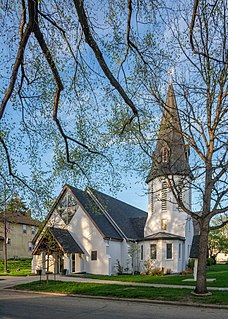
Saint Thomas Church is an Episcopal parish church of the Episcopal Diocese of New York at 53rd Street and Fifth Avenue in Midtown Manhattan, New York City. Also known as Saint Thomas Church Fifth Avenue or Saint Thomas Church in the City of New York, it was incorporated on January 9, 1824. The current structure, the congregation’s fourth church, was designed by the architects Ralph Adams Cram and Bertram Grosvenor Goodhue in the French High Gothic Revival style and completed in 1914.

The Cathedral Church of St. Paul is the cathedral church of the Episcopal Diocese of Michigan. In 1824 its congregation formed as the first Episcopal and first Protestant church in Michigan Territory.

Mariners' Church of Detroit is a church with worship services adhering to Anglican liturgical traditions located at 170 East Jefferson Avenue in Downtown Detroit, Michigan. It was founded in 1842 as a special mission to the maritime travelers of the Great Lakes and functioned as a parish of the Episcopal Diocese of Michigan until 1992, when the Michigan Court of Appeals ruled it was incorporated as an independent congregation. The church was listed on the National Register of Historic Places in 1971. The church is now part of the REC Diocese of Mid-America within the Anglican Church in North America.

Grace Church is a historic parish church in Manhattan, New York City which is part of the Episcopal Diocese of New York. The church is located at 800–804 Broadway, at the corner of East 10th Street, where Broadway bends to the south-southeast, bringing it in alignment with the avenues in Manhattan's grid. Grace Church School and the church houses—which are now used by the school—are located to the east at 86–98 Fourth Avenue between East 10th and 12th Streets.

St. Mary's Episcopal Church is an historic Carpenter Gothic church located at 400 St. Johns Avenue in Green Cove Springs, Florida. On February 17, 1978, it was added to the U.S. National Register of Historic Places.

St. Peter's Episcopal Church, also known as St. Peter's Church, is located in downtown Albany, New York, United States. It was designed in the mid-19th century by Richard Upjohn and his son Richard M. Upjohn in the French Gothic Revival architectural style. It was listed on the National Register of Historic Places in 1972, and designated a National Historic Landmark eight years later. It is also a contributing property to the Downtown Albany Historic District.

The Central Woodward Christian Church, now known as Historic Little Rock Missionary Baptist Church, is a Gothic Revival church located in Detroit, Michigan. It was listed on the National Register of Historic Places in 1993.

The Metropolitan United Methodist Church is a church located at 8000 Woodward Avenue in the New Center area of Detroit, Michigan. It was completed in 1926, listed on the National Register of Historic Places in 1982, and designated a Michigan State Historic Site in 1986. This church should not be confused with Metropolitan United Methodist Church in Washington, DC, which is often regarded as a National Church within the United States as it was specifically established by the General Conference to be a "representative presence of Methodism in the nation's capital".

St. Joseph's Episcopal Church, now known as St. Matthew's-St. Joseph's Episcopal Church, is a historic Episcopal church located at 8850 Woodward Avenue in Detroit, Michigan, and is part of the Episcopal Diocese of Michigan. It was added to the National Register of Historic Places in 1982.

The Woodward Avenue Presbyterian Church is a church located at 8501 Woodward Avenue in Detroit, Michigan. Built in 1911 in the Gothic Revival style, the architect was Sidney Badgley. It was used for some time as the Abyssinia Church of God in Christ. The building was listed on the National Register of Historic Places in 1982.

The First Unitarian Church of Detroit was located at 2870 Woodward Avenue in Midtown Detroit, Michigan. Built between 1889 and 1890, it was listed on the National Register of Historic Places in 1982. It was destroyed by fire on May 10, 2014.

The Our Lady of the Rosary Roman Catholic Church is located at 5930 Woodward Avenue in Detroit, Michigan. It was originally built as St. Joseph's Episcopal Church - from 1893 to 1896 - and is a historic Romanesque Revival church complex. It was added to the National Register of Historic Places on August 3, 1982.

The Park United Presbyterian Church is located at 14 Cortland Street in Highland Park, Michigan. It was built in 1910 as the Highland Park Presbyterian Church, listed on the National Register of Historic Places in 1982, and designated a Michigan State Historic Site in 1983. It is a member of The Presbyterian Church (U.S.A.), and continues to offer services.

Calvary Episcopal Church is a parish of the Episcopal Diocese of Pittsburgh, Pennsylvania, that was founded in 1855.

St. Luke's Episcopal Church is a historic Episcopal church located on Bedford Road in Katonah, New York, United States. It is a Tudor Revival structure dating to the early 1920s, housing a congregation restarted in the early 20th century.

St. Michael's Episcopal Church, Parish House and Rectory is a group of architecturally-significant religious buildings located at 200-216 North Mill Street in Birdsboro, Berks County, Pennsylvania. It was added to the U.S. National Register of Historic Places in 1982.

The Grosse Pointe Memorial Church (GPMC) is a church located at 16 Lake Shore Drive in Grosse Pointe Farms, Michigan, USA. it is a member of the Presbyterian Church, USA (PCUSA). It was designated a Michigan State Historic Site in 1990 and listed on the National Register of Historic Places in 1993.

St. Thomas Episcopal Church is a parish church in the Episcopal Diocese of Iowa. The church is located in Sioux City, Iowa, United States. The church building was listed on the National Register of Historic Places in 1984.

The Church of the Good Shepherd in Rosemont, Pennsylvania, is a progressive and inclusive Episcopal parish church in the liberal Anglo-Catholic tradition. It is part of the Episcopal Diocese of Pennsylvania and is located in the Philadelphia Main Line.

St. George's Episcopal Memorial Church, a historic Episcopal church in Bismarck, North Dakota's capital, is unique for its construction incorporating stained glass from English churches bombed in World War II into its own stained-glass windows. It is located in the Episcopal Diocese of North Dakota and was added to the National Register of Historic Places in 2021. The building, completed in 1949, replaced an early one dating to 1881 in the Dakota Territory, prior to statehood in 1889. The original building was built on railroad-donated land in the first decade of the city's growth. The church needed more space by the 1930s but was unable to erect a larger building until after World War II. The original building was moved and repurposed as a museum at Camp Hancock State Historic Site. The newer building is notable for being constructed of pumice concrete and its unique stained-glass windows. The windows were made in England by Barton, Kinder, and Alderson, and the majority of them contained pieces of glass that were salvaged from dozens of damaged churches in southeast England during World War II. The glass studio documented the lineage of each window, with some made with glass collected from churches built in the Middle Ages.

























